Improve Basketball Shooting with the Optimal Arc, Entry Angle and Entry Depth for Increased Scoring Percentage
Basketball shooting percentages have been flat or decreasing at all levels of competition. For example, the National Basketball Association average free throw shooting percentage has been constant at about 74% since 1958. It is difficult to think of a performance statistic in any other sport that has shown no improvement in the last 45 years.
At Noah Basketball, we have spent a number of years investigating the arc of outside shots and how arc affects shooting percentage. Our research included numerous studies of ball flight, two scientifically controlled motor skill studies and thousands of Noah feedback sessions with basketball players from middle school through NBA professionals. We observed that most shots miss because they are too short or too long. If a shooter cannot accurately control their arc, then the depth of their shot will also change. Since shooters at all levels have difficulty controlling arc, their shot depth control suffers and their scoring percentages drop.
This page summarizes the Noah Basketball learning. We'll begin by explaining the important concepts of a basketball shooting arc. Then we'll give some examples that show how much scoring percentage can increase with improved arc control.
What is a Basketball Shooting Arc?
Arc is the path the basketball flies from the time it leaves the shooter's hand until it arrives at the basket. Once in the air, gravity is the only force affecting the ball, so the flight is completely predictable for a given release direction, release point and release strength. Photo 1 shows the ball flight at multiple times on the way to the basket. The ball flight always takes the shape of a parabola.
By drawing a line through the center of the ball in Photo 1, we can visualize the exact parabolic path that the ball takes from the shooter's hand to the basket. This visualization is shown in Photo 2.

Measuring Basketball Shooting Arc
Some diagrams will help to clarify the important concepts. We define arc as the angle that the ball enters the hoop, because what matters in scoring is what happens at the hoop.
If a ball enters the hoop directly from above, as in Figure 1, this is a 90 degree arc. Unless you are dunking the ball, a 90 degree arc is impossible. Free throws and jump shots always come into the hoop at an angle. A ball entering the hoop directly from the side is a 0 degree arc, which is impossible to score.
Free Throws and Jump Shots always come in at an angle. Figure 2 shows shots with a variety of arcs. The red line represents a 30 degree arc, which is very low. The blue line represents a 60 degree arc, which is very high. Finally, the green line represents a 45 degree arc, a more optimal height.

Figure 1: Extreme Entry Points: 90° Arc enters directly from above, 0° Arc enters directly from the side
Figure 2: (Red) 30˚, (Green) 45˚ and (Blue) 60˚ Arcs
What the Ball Sees
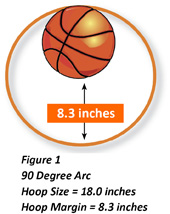
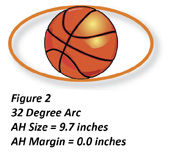
If a ball enters the hoop directly from above, this is a 90 degree arc. If the 90 degree ball had eyes, the hoop would look perfectly round with an 18 inch opening as shown in Figure 1. Since a men's ball is 9.7 inches in diameter, the amount of open space left in the hoop is 18 – 9.7 = 8.3 inches. This is called the hoop margin.
Jump shots and set shots from the outside do not enter the hoop with a 90 degree arc. Instead they enter at an angle which means that the hoop looks like an ellipse rather than a circle.
The flatter the arc, the smaller the ellipse, called the Apparent Hoop Size (AH Size). If a 32 degree ball had eyes, the hoop would look just large enough for the ball to squeeze through as shown in Figure 2. The Apparent Hoop Size is 9.7 inches, the same size as a men's basketball.
Now we can calculate the Apparent Hoop Margin, which is the Apparent Hoop Size minus the diameter of the ball. At an arc of 32, the Apparent Hoop Margin (AH Margin) is 0 inches, allowing no room for shooter error.
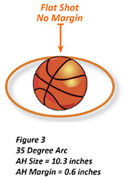
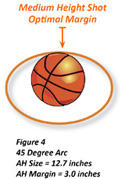
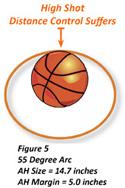
As the arc is increased to 35, 45 and 55 degrees, the Apparent Hoop Size (AH Size) and the Apparent Hoop Margin (AH Margin) become larger as shown in Figures 3, 4 and 5.
Shot Depth Control
If the Apparent Hoop Margin is larger for a higher arc, then it seems like the higher arc would lead to more made shots. Unfortunately, Apparent Hoop Margin is only part of the scoring story. The other key issue is shot depth control. Even with the same level of shooting skill, physics laws show it is more difficult for a shooter to control shot depth when shooting a higher arc. This explains why the best shooters do not have extremely high arcs on their shots.
These diagrams will help to explain. For example, even though the hoop gets larger as the arc increases from 45 to 55 degrees, the loss of shot depth control increases even more than the increase in Apparent Hoop Margin.
Figure 1 shows a shooter with a 6 foot release height trying to shoot a 3-point shot with a 55 degree arc (shown in green). The 55 degree arc goes through the hoop. But if the shooter accidentally shoots 1 degree lower, a 54 degree arc (shown in red), the laws of physics will cause the ball to travel a greater shot depth. In fact the ball will go exactly 3.3 inches further; just enough to bounce off the back of the rim.
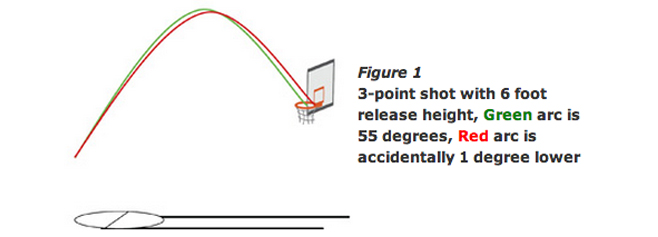
If the shooter accidentally shoots 1 degree higher, a 56 degree arc (shown in blue) in Figure 2, the ball will travel 3.6 inches less and bounce off the front of the rim.
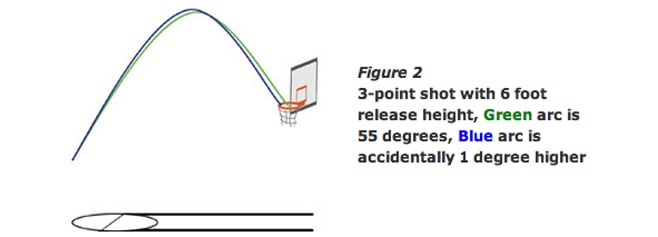
Free Throw Shooting Skill Levels
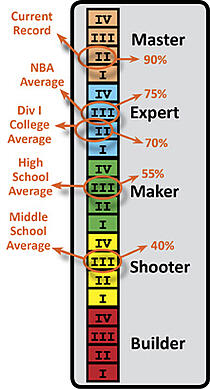
As described above, an accidental arc change of 1 degree in either direction (a total range of 2 degrees) on a high arc shot can cause the ball to rim out. Noah Basketball needed to learn whether it was difficult for an athlete to keep his arcs within a 2 degree range.
After measuring thousands of Noah sessions, we learned that only 1 percent of the basketball playing athletes can control their arc to this level of accuracy. The rest of us have a large amount of variation in shot arcs which causes the ball to go short or long and often keeps the ball from scoring.
Noah Basketball has defined a term called Shooting Skill Level which measures how well a shooter can control their arc and shot depth. As shown in the table below, the Shooting Skill Levels range from Builder to Master, with the very highest performance at the top of the scale.
A Shooting Skill Level of Master IV is perfect and means that a shooter can shoot 25 shots in a row with exactly the same arc and shot depth. So far this perfect Shooting Skill Level has never been achieved. The best Shooting Skill Level measured to date is Master II and has been demonstrated by some of the very best professional and college athletes. On the other end of the scale, a skill level of Builder I demonstrates only minimal control.
Examples of Shooting Skill Levels and Impact on Game Scoring Percentage
A shooter's Shooting Skill Level is closely tied to his or her Game Scoring Percentage, meaning the percentage of shots that go through the hoop.
This relationship between Shooting Skill Level and Game Scoring Percentage has been shown in scientific studies, theoretical analysis and in game box scores.
Let us review a couple examples to show the importance of Shooting Skill Level.
Example A:
A high school player shoots a free throw with women's ball from a release height of 6 feet with an average arc of 45 degrees. This player has a Shooting Skill Level of Maker III and a game free throw percentage of 55%. Holding all other factors constant (fatigue, nervousness, direction control), the shooter's game free throw percentage will increase as shown in Table 1.

Example B:
A college player shoots a 3-point shot with men's ball from a release height of 9 feet with an average arc of 43. This player has an Shooting Skill Level of Expert II and a game 3-point percentage of 30%. Holding other factors constant (fatigue, nervousness, direction control), the shooter's game 3-point percentage will increase as shown in Table 2.

Chris Mullin, NBA All-Star and Shooting's Gold Standard

Photo 1: Chris Mullin's Plot of 25 Shot Arcs at Master I Skill Level
Individual Basketball Shooting Improvement
Now let us compare the path of Chris Mullin’s 25 shots with those of an 8th Grade point guard shown in Photo 2. The orange lines in Photo 2 show the area where the arcs are most different from each other. The arcs of these 25 shots are typical of a middle school athlete and represent a Shooting Skill Level of Shooter II. The shooter was a 40% game free throw shooter.
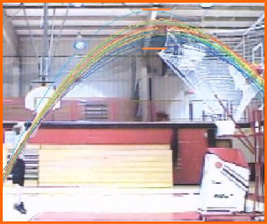
Photo 2: Middle School Shooter Day One - Plot of 25 Shot Arcs at Shooter III Skill Level
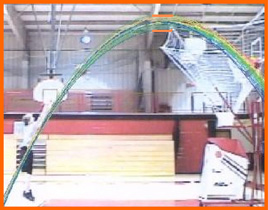
Photo 3: Middle School Shooter Day Three - Plot of 25 Shot Arcs at Maker III Skill Level
This 8th Grade point guard practiced shooting free throws with Noah instant verbal arc feedback on three days over a two week period. During every Noah practice session, he tried to achieve a 45 degree arc on every shot.
The first practice day he took 75 shots with Noah feedback and improved his Shooting Skill Level to Maker I.
The second practice day he took 100 shots with Noah feedback and improved his Shooting Skill Level to Maker II .
The third practice day the shooter was so excited about his improvement using Noah that it was hard to get him to stop shooting.
He took 200 free throw shots with Noah feedback and improved his Shooting Skill Level to Maker III The orange lines in Photo 2 show the area where the arcs are most different from each other. Notice the difference in the spacing of the orange lines from Photo 2 to Photo 3. The arc consistency was dramatically improved in only three days of practice. With continued Noah practice, this shooter will carry this improved shooting ability into games with an expected improvement of over 30 percentage points.
Summary
Coaches and shooters have known for many years that arc was important to consistent scoring, but serious training for the arc has never been possible. As a result, many promising athletes have not performed up their scoring potential. Using the Noah system of instant verbal arc feedback, athletes at any level can improve their arc consistency, improve their shot depth control and increase their Shooting Skill Level at a rapid pace, resulting in deeply ingrained muscle memory and more points scored.











